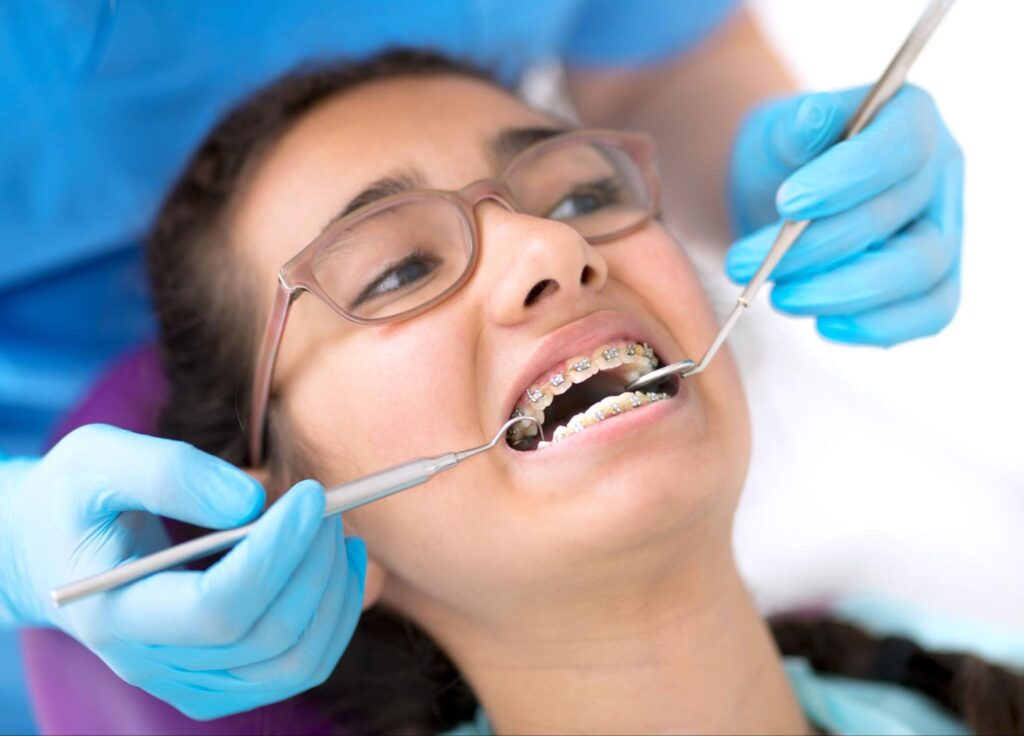So you’ve finally gotten your braces— now how exactly do you keep these things clean? At Sturbridge Orthodontics, we know your treatment is far from over once you get your braces. Today, we’ll lay out a comprehensive guide with tips for keeping your braces clean.
Unpacking the Components
Metal and ceramic braces comprise several essential components. It’s crucial to grasp their functions for practicing adequate care.
- Brackets: These are affixed to your teeth and crafted from either metal or ceramic material, as determined during our consultation.
- Wires: These wires serve as the mechanism for exerting force to realign your teeth, and they interconnect the entire structure.
- Bands: These aid in securing the wires to the brackets. When you observe individuals with colorful braces, you’re actually noticing colorful bands.
How to Clean Your Braces
Dr. Sabelis, like all orthodontists, advises patients with braces to maintain a kit containing essential tools for cleaning their braces at certain intervals throughout the day. These kits typically include items such as:
- Soft-Bristle Toothbrush
- Orthodontic Wax
- Floss Threader
- Fluoride Mouthwash
- Compact Mirror
- Interdental Brush
Now that we’ve discussed the necessary tools, let’s review how to effectively utilize them! While completing every step on this list may not be feasible for every cleaning session, adhering to these guidelines remains crucial. The primary objective of cleaning is to eradicate bacteria, the primary culprit behind decay when left unchecked.
- Start with a Rinse: Start the cleaning process by rinsing with water to eliminate any loose debris.
- Brush Thoroughly: Utilize the same brush to meticulously clean between brackets and wires. Glide the brush in and out between each bracket to remove food particles and plaque.
- Clean Between Brackets: Utilize the same brush to meticulously clean between brackets and wires. Glide the brush in and out between each bracket to remove food particles and plaque.
- Floss with Threader/Orthodontic Floss: Carefully thread the floss through the brackets and wires using a floss threader or orthodontic floss. Floss between each tooth for thorough cleaning.
- Water Flosser: Consider integrating a water flosser into your routine for effective debris removal from hard-to-reach areas. Water flossers are particularly beneficial for individuals with braces, as they efficiently cover extensive areas.
- Fluoride Mouthwash: Conclude your oral care regimen by gargling with fluoride mouthwash. Choose an alcohol-free variant to prevent irritation. Swish the mouthwash for approximately 30 seconds before spitting it out, ensuring no ingestion.
- Check for Debris: Use a small mirror to inspect for any remaining debris or areas needing attention.
- Orthodontic Wax: If brackets or wires cause gum irritation, apply orthodontic wax as a protective barrier against sharp edges.
How to Care for Your Braces
However, cleaning is only the beginning! There are numerous additional ways to care for your braces. Adopting positive habits and avoiding negative ones can significantly enhance your overall experience. Let’s discuss some of the beneficial practices:
- Oral Hygiene: We’re emphasizing this once more for good measure! It’s the cornerstone of caring for any orthodontic appliance, particularly a full set of braces. Failure to maintain proper hygiene can lead to various issues.
- Avoid Certain Foods: Braces represent an investment, and safeguarding them from damage is paramount. Avoid hard, sticky, or chewy foods like popcorn, toffee, or gum, as they can cause damage to your braces’ components and become lodged between them.
- Regular Check-Ups: Your treatment plan requires scheduled visits to our office for assessment and addressing any concerns. Aim to attend every appointment and continue attending routine cleanings with your general dentist.
- Follow the Rules: Dr. Sabelis will provide specific care instructions as part of your treatment plan—adhere to these instructions diligently.
- Wear a Mouthguard: Sports enthusiasts should prioritize additional protection. A custom mouthguard offers optimal tooth protection against impact.
- Stay Hydrated: Drink plenty of water, particularly after consuming sugary or acidic foods, to flush away particles and prevent decay.
- Maintain a Healthy Diet: Nutrient-rich foods contribute to overall oral and bodily health.
- Emergency Kit: Simplify your cleaning essentials to some orthodontic floss, a compact toothbrush and mirror, and orthodontic wax, even when traveling light.
Service You Can Count On
We take great pride in serving the Sturbridge community and offering braces to patients of all ages. While braces may seem like a significant undertaking, the end results are always worthwhile! You can reach our office at (508) 347-7540 for a free consultation.










